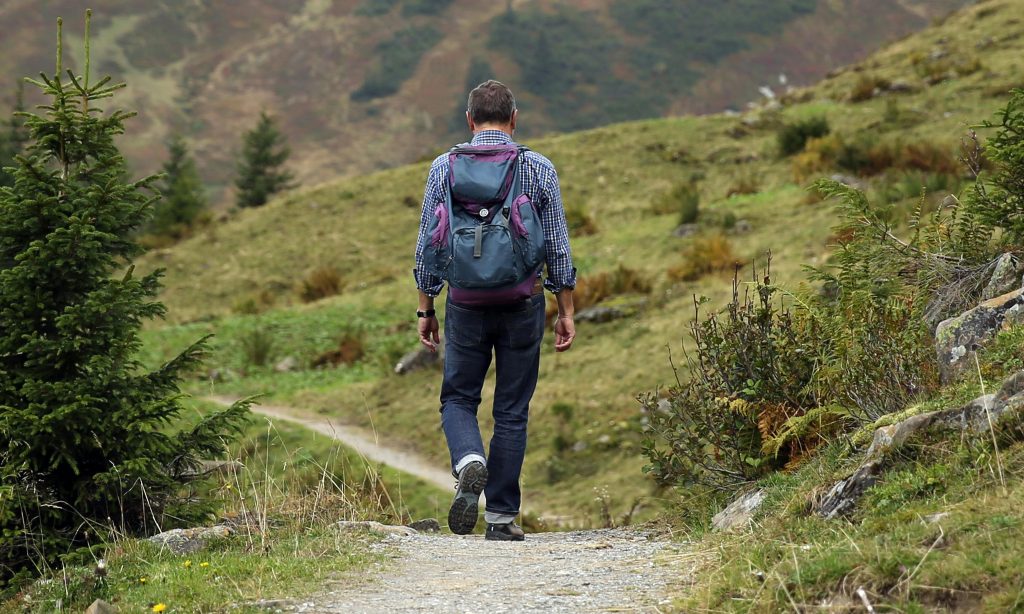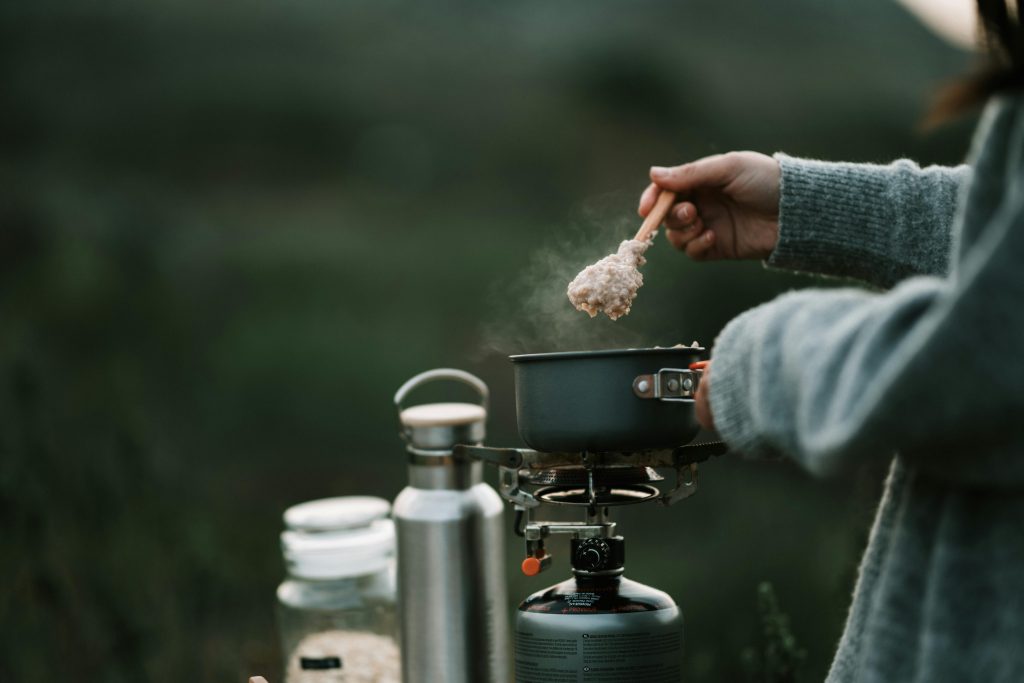We know from experience that among our customers there are the most diverse motivations and motives for keeping a stock of food. We at SicherSatt AG are deliberately politically and denominationally neutral and unbiased with regard to the personal convictions of our customers. We produce and sell long-lasting food of the best quality and thus want to help satisfy our customers’ need for food security.
Types of outdoor food
8. April 2024

Outdoor nutrition includes a diverse range of foods and meals specifically designed for consumption during outdoor activities and adventures. Whether hiking, camping, climbing or other outdoor adventures, proper nutrition is important for performance, endurance and well-being in the great outdoors. In this post, we explore the world of outdoor nutrition, from convenient dry meals to high-energy snacks, and learn how careful planning and preparation can help us meet our culinary needs in the wilderness.
The selection of food for outdoor food
It’s essential to choose foods that are not only lightweight and compact but also provide sufficient nutrients to support energy and endurance during the adventure. When selecting outdoor foods, consider several factors:
- Weight: Lightweight foods are crucial to minimize backpack load and maintain mobility during the activity. Dry meals, freeze-dried foods, and portion-sized snacks are often the best choice.
- Durability: Since outdoor activities often occur under various conditions, choose foods with long shelf lives to prevent spoilage and reduce the risk of food loss during the journey.
- Nutrient content: Foods should provide a balanced mix of carbohydrates, proteins, healthy fats, vitamins, and minerals to meet energy needs during the activity and support muscle recovery.
By carefully planning and selecting foods, outdoor enthusiasts can ensure they are adequately nourished during their adventures while optimizing their backpack weight.
Types of outdoor food
For outdoor adventures, there is a variety of food specifically designed to meet the demands of being on the go. Here are some common types of outdoor food that accompany adventurers on their expeditions:
- Dry and Ready-to-Eat Meals
Dry and ready-to-eat meals are extremely convenient and require no elaborate preparation. They are typically available in lightweight packaging, providing a quick and straightforward meal on the go. These types of food range from simple soups and stews to complete meals that only require water to prepare. Dry and ready-to-eat meals are ideal for hiking, camping trips, and other outdoor activities where carrying fresh food is not practical.
- Energy Bars and Snacks
Energy bars and snacks are perfect companions for outdoor activities as they provide quick energy and are easy to consume. They come in a variety of flavors and nutrient compositions to meet different needs and preferences. Popular snacks for on the go include nuts, freeze-dried fruits, beef jerky, and granola bars. Energy bars are a convenient way to maintain energy levels during long hikes or trekking trips without the need for elaborate preparation.
- Freeze-Dried and Dehydrated Foods
Freeze-dried and dehydrated foods are an excellent option for outdoor enthusiasts as they are lightweight, have a long shelf life, and take up little space. These foods are preserved by removing water and can be quickly rehydrated by adding hot water. They are available in various varieties, including freeze-dried fruits, vegetables, soups, and even complete meals. Freeze-dried and dehydrated foods are an excellent choice for multi-day hikes, camping trips, and expeditions where lightweight and nutritious meals are needed.
- Homemade Meals and Recipes
Some outdoor enthusiasts prefer to prepare their own meals using special recipes for on the go. These homemade meals allow adventurers to tailor the ingredients and nutrients precisely to their needs while adding a personal touch. Popular homemade options include pasta salads, wraps, sandwiches, and couscous dishes. Homemade meals are a fantastic way to experience culinary enjoyment even during outdoor adventures while considering individual dietary needs.
By selecting the right type of outdoor food, adventurers can ensure they are well-nourished during their travels and have the energy to enjoy their activities.
Tips for outdoor food on the go
Eating well on the go requires a bit of planning and preparation. Here are some practical tips to help you optimize your meals during outdoor adventures:
- Simple Preparation Methods Without Kitchen Equipment
When on the go, simple preparation methods without complicated kitchen equipment are crucial. Choose foods that are easy to prepare and require minimal cooking utensils. Some examples include instant noodles, ready-to-eat meals that only require hot water, and snacks that are ready to eat immediately. Avoid complicated recipes that require a lot of time and effort, and focus on simple meals that can be quickly and easily prepared.
- Storage and Transport of Food
Proper storage and transport of food are crucial to maintain its freshness and quality during your outdoor adventures. Use airtight containers or Ziploc bags to protect food from moisture and odors. Separate raw foods from already cooked or ready-to-eat foods to avoid cross-contamination. Ensure perishable foods such as meat and dairy products are stored in a cooler to maintain proper refrigeration.
- Hydration and Water Purification
Maintaining adequate hydration is crucial during outdoor adventures. Make sure to carry enough water and drink regularly to avoid dehydration. Use water purification methods such as water filters, chemical disinfectants, or UV light as needed to make water from natural sources safe to drink. Always carry a sufficient amount of water with you and plan your route accordingly to utilize water sources along the way.
By considering these tips, you can ensure that you are well-nourished during your outdoor adventures and have enough energy to enjoy your activities.
General tips
Nutrition and Energy Requirements:
- Considering the Increased Energy Demand: Outdoor activities often require increased energy intake due to elevated metabolism and physical exertion.
- Balanced Nutrition and Nutrient Intake: It’s essential to ensure a balanced diet that provides all necessary nutrients for energy, muscle recovery, and endurance.
- Selection of High-Energy and Nutrient-Rich Foods and Snacks: This includes foods such as nuts, dried fruits, whole grains, protein-rich foods, and hydrating options like fruits and vegetables.
Sustainability and Environmental Awareness:
- Environmentally Friendly Packaging: Opting for reusable or biodegradable packaging reduces waste and conserves the environment.
- Waste Minimization: Careful planning and avoidance of disposable products can minimize waste and protect the natural environment.
Safety and Health:
- Prevention of Food Poisoning: Proper food hygiene and storage at appropriate temperatures help prevent food poisoning.
- Proper Handling of Food: Different climatic conditions require different storage methods to ensure food durability and maintain its quality.
- Emergency Preparedness and First Aid Measures: A solid understanding of first aid and emergency preparedness is crucial to respond appropriately to outdoor accidents or illnesses and ensure the safety of all participants.
Conclusion
The selection and preparation of outdoor food is important for the well-being and success of outdoor activities. Through careful planning, consideration of energy requirements, selection of nutritious foods and attention to environmental aspects, outdoor enthusiasts can enjoy their adventures safely and healthily. In addition, a sound knowledge of first aid and emergency preparedness is essential to minimize potential risks and respond appropriately to unforeseen situations. With a balanced diet, environmental awareness and safety measures, outdoor adventures can become unforgettable experiences in nature.

